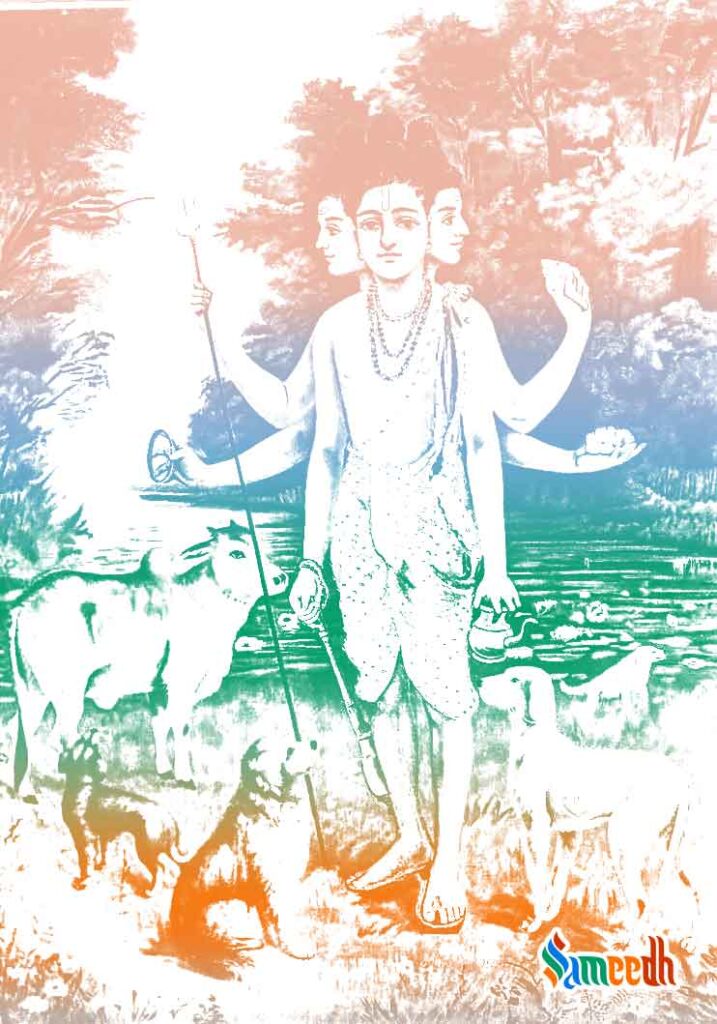The triple headed god of Hinduism with the combined powers of the Trimurti.

ORIGIN
Dattatrey was a monk who personified the trinity or Trimurti of Hinduism; Brahma – god of creation, Vishnu – god of preservation and Shiva – god of destruction. He is deemed as the amalgamation of the three most significant deities of the religion. Dattatrey is formed with two words deriving its meaning from Sanskrit. Datta means to give and Attrey is the name of Dattatrey’s father, Atri.
Dattatrey was born to parents Atri and Anusuya. Atri himself was a great sage. The birth of this great soul was through a test that his mother passed. She was a devout wife who religiously followed her husband and lived her life as a dutiful life. She had always prayed in meditative states to get a child with the qualities of the holy trinity themselves. To test her devotion towards Atri, the three goddesses or Trivedi hatched a plan. They did this when Narad went to Anusuya asking her to fry iron balls for him to eat after the goddesses refused to do so. Tridevi claimed that it is an impossible task. Anusuya had water left from washing her husband’s feet so she used it to fry the iron balls successfully as it was sacred and holy. Narad reported this to the three deities stating how they could’ve done this had they served their husbands dutifully. They then designed a chastity test for Anusuya by sending their husbands to gather alms from her in a fully nude state. Upon their arrival, Anusuya was in a great dilemma but she figured a way around it. Through her years of spiritual powers that she had gathered from her prayers and meditation, she converted the trio into three innocent children. She then fed them and passed the test resulting in the birth of Dattatrey with the collective powers of the three deities.
SIGNIFICANCE
He manifests the combined strengths of the three supreme forces. He is believed to have been a sanyani, a person who reaches the highest state of consciousness through meditative practices. He was the first teacher of Adi Sampradaya of the Nathas and their followers, a sub tradition in Hinduism. He was also regarded as the lord of Yoga and was known for performing tantric practices.
He was the one with 24 gurus or teachers who taught him various meanings of life through their characteristics like Earth, Wind, Sky, Fire, Moon, Pigeons etc.
PHYSICAL FORM
As Dattatrey was a combination of three gods, he had several physical distinctions because of it. He has two feet, six hands and three heads. His triple heads signify the immense amount of knowledge and wisdom he carries. His hand each carries rosary beads, a conch shell or Shankh, a circular disc or chakra, a pot of water known as Kamandalu, a trident or trishul and a small drum. The Shankh emits positive vibrations through sounds while the water pot is said to be filled with drops of wisdom. The Chakra symbolises the Universe and is used in mythological tales as a weapon of destroying evil forces and entities. The Trident too is used to put an end to evil sentiments like ego and greed; the sound of the drum is known to shake free ignorance from people’s minds. Each of these holy objects have belonged to the deities themselves and were passed down to this humble monk.
Dattatrey is often spotted with four dogs, a cow and a tree. The dogs represent the four cycles of life, the four epochs of time or Yug and Vedas, ancient religious texts of Hinduism.
IMPORTANT DAY
Dattatrey is believed to be born on a full moon day or Purnima according to the Hindu calendar. It was during the phase of Margashirsha, from the month of December to January. That day is celebrated in his honour as Dattatrey Jayanti.
